All About Financial Quantitative Analysts
Job Description: Develop quantitative financial products used to inform individuals or financial institutions engaged in saving, lending, investing, borrowing, or managing risk. Investigate methods for financial analysis to create mathematical models used to develop improved analytical tools or advanced financial investment instruments.
A Day in the Life of a Financial Quantitative Analyst
- Collaborate with product development teams to research, model, validate, or implement quantitative structured solutions for new or expanded markets.
- Define or recommend model specifications or data collection methods.
- Consult traders or other financial industry personnel to determine the need for new or improved analytical applications.
- Assess the potential impact of climate change on business financial issues, such as damage repairs, insurance costs, or potential disruptions of daily activities.
- Prepare requirements documentation for use by software developers.
- Research new financial products or analytics to determine their usefulness.
Featured schools near , edit
What Every Financial Quantitative Analyst Should Know
When polled, Financial Quantitative Analysts say the following skills are most frequently used in their jobs:
Mathematics: Using mathematics to solve problems.
Critical Thinking: Using logic and reasoning to identify the strengths and weaknesses of alternative solutions, conclusions or approaches to problems.
Reading Comprehension: Understanding written sentences and paragraphs in work related documents.
Complex Problem Solving: Identifying complex problems and reviewing related information to develop and evaluate options and implement solutions.
Active Listening: Giving full attention to what other people are saying, taking time to understand the points being made, asking questions as appropriate, and not interrupting at inappropriate times.
Speaking: Talking to others to convey information effectively.
Related Job Titles
- Financial Quantitative Analyst
- Quantitative Analyst
- Quantitative Model Validation Analyst
- Investment Strategist
- Quantitative Researcher
Is There Job Demand for Financial Quantitative Analysts?
In the United States, there were 135,900 jobs for Financial Quantitative Analyst in 2016. New jobs are being produced at a rate of 9.6% which is above the national average. The Bureau of Labor Statistics predicts 13,100 new jobs for Financial Quantitative Analyst by 2026. The BLS estimates 13,100 yearly job openings in this field.
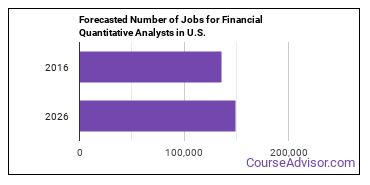
The states with the most job growth for Financial Quantitative Analyst are Utah, Nevada, and Arizona. Watch out if you plan on working in South Dakota, Maryland, or Alaska. These states have the worst job growth for this type of profession.
Salary for a Financial Quantitative Analyst
The salary for Financial Quantitative Analysts ranges between about $38,030 and $123,360 a year.
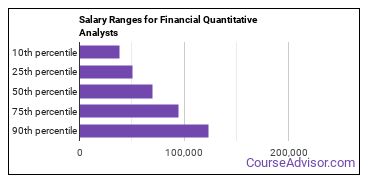
Financial Quantitative Analysts who work in District of Columbia, Virginia, or Illinois, make the highest salaries.
Below is a list of the median annual salaries for Financial Quantitative Analysts in different U.S. states.
| State | Annual Mean Salary |
|---|---|
| Alabama | $75,170 |
| Alaska | $68,040 |
| Arizona | $82,200 |
| Arkansas | $43,580 |
| California | $80,720 |
| Colorado | $83,800 |
| Connecticut | $77,690 |
| Delaware | $80,950 |
| District of Columbia | $107,760 |
| Florida | $67,520 |
| Georgia | $85,610 |
| Idaho | $56,440 |
| Illinois | $93,200 |
| Indiana | $66,590 |
| Iowa | $69,480 |
| Kansas | $55,300 |
| Kentucky | $57,030 |
| Louisiana | $61,170 |
| Maine | $65,430 |
| Maryland | $77,440 |
| Massachusetts | $88,370 |
| Michigan | $69,480 |
| Minnesota | $74,190 |
| Mississippi | $63,650 |
| Missouri | $74,050 |
| Montana | $67,820 |
| Nebraska | $79,250 |
| Nevada | $58,150 |
| New Hampshire | $77,670 |
| New Jersey | $81,660 |
| New Mexico | $61,940 |
| New York | $96,480 |
| North Carolina | $76,050 |
| North Dakota | $77,400 |
| Ohio | $78,960 |
| Oklahoma | $72,520 |
| Oregon | $71,980 |
| Pennsylvania | $74,880 |
| Rhode Island | $77,610 |
| South Carolina | $69,340 |
| South Dakota | $53,080 |
| Tennessee | $65,200 |
| Texas | $70,830 |
| Utah | $69,340 |
| Vermont | $72,600 |
| Virginia | $87,810 |
| Washington | $73,790 |
| West Virginia | $68,180 |
| Wisconsin | $60,120 |
| Wyoming | $59,190 |
What Tools do Financial Quantitative Analysts Use?
Although they’re not necessarily needed for all jobs, the following technologies are used by many Financial Quantitative Analysts:
- Microsoft Excel
- Microsoft Office
- JavaScript
- Microsoft PowerPoint
- Web browser software
- Python
- Microsoft Access
- Microsoft Visio
- Structured query language SQL
- The MathWorks MATLAB
- Microsoft Dynamics
- SAS
- Linux
- Microsoft Visual Basic
- IBM SPSS Statistics
- Microsoft SQL Server
- UNIX
- R
- Oracle JD Edwards EnterpriseOne
- Practical extraction and reporting language Perl
How to Become a Financial Quantitative Analyst
What education or degrees do I need to become a Financial Quantitative Analyst?
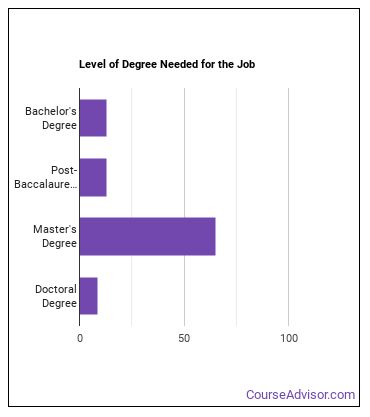
How Long Does it Take to Become a Financial Quantitative Analyst?
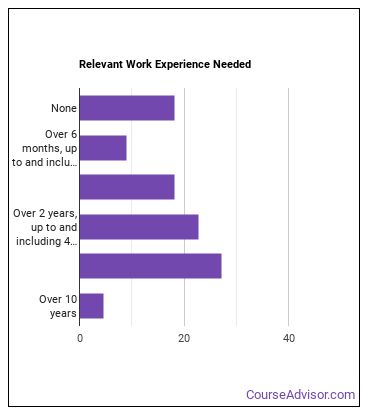
Where Financial Quantitative Analysts Work
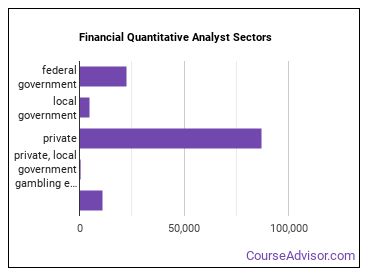
Below are examples of industries where Financial Quantitative Analysts work:
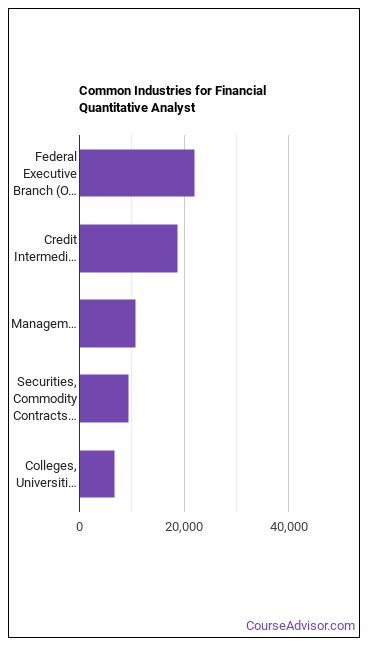
References:
Image Credit: Dave Dugdale via Creative Commons Attribution-Share Alike 2.0 Generic
More about our data sources and methodologies.
Featured Schools
 Request Info
Request Info
|
Southern New Hampshire University You have goals. Southern New Hampshire University can help you get there. Whether you need a bachelor's degree to get into a career or want a master's degree to move up in your current career, SNHU has an online program for you. Find your degree from over 200 online programs. Learn More > |
